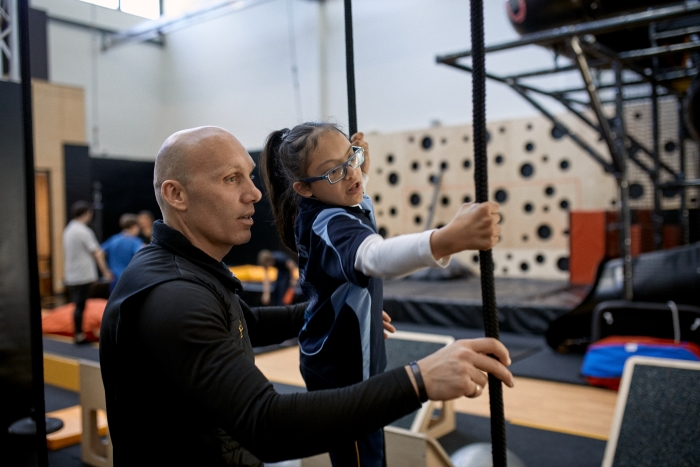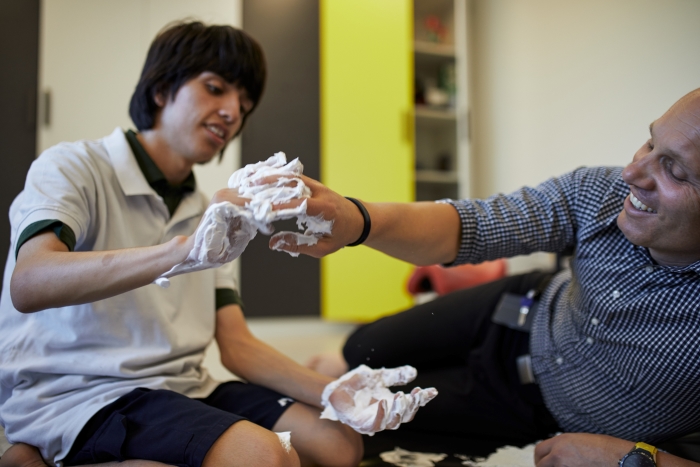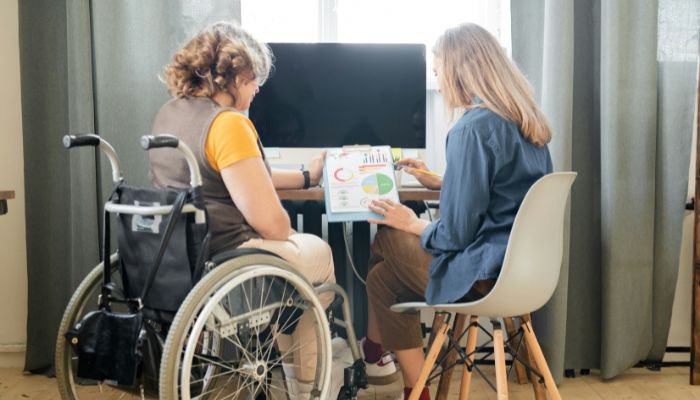
Dino Mennillo is the Director of OTFC Group, South Australia’s longest-standing private paediatric occupational therapy practice. Qualified as an Occupational Therapist (OT) since 1993, he took the time to explain how occupational therapy can benefit children, teens and adults with disability, the joy of therapy through play, and how you can maximise therapy time for life-changing results.
Occupational therapy is a really broad field – we basically are looking at people’s lives and how they participate in day-to-day activities, finding ways to help them overcome challenges and be as independent and functional as they would like to be.
Occupational therapy can help with a rehabilitation process after an injury, getting muscles functioning, but it is also about access, how to use things, and how make modifications to environments like homes, schools or workplaces.
In the area of paediatrics, we deal a lot with families with children who have diagnoses of developmental conditions like autism, intellectual disability, or cerebral palsy – things that impact on how a child typically develops – and how to compensate or provide therapy to improve elements of function.
We help children attend mainstream school or support them being able to access special school. We also support children and young people with learning difficulties, sensory processing disorders, behavioural concerns, and coordination challenges.
OTFC Group liaises with health professionals to help them with a holistic view of the child – basically, we go where people need us to support them.
Part of what we do is also to educate. I do a lot of professional development training for schools and health professionals, understanding the differences that exist, and the strengths and challenges for each child.
We are mindful that our role, particularly in this practice, is that we always ensure the family and caregivers feel a sense of empowerment. They have control of decision making. It doesn’t mean we always agree, but we respect that.
In our clinics, we support children from 12 months to adults and really, the earlier the better when it comes to treatment and support. We often see younger children when parents are concerned their child is not reaching milestones at appropriate times and they may be referred by a paediatrician or other allied health professional.
Then we might see another cohort at four or five years of age if there are concerns that they aren’t ready for school or are not keeping up with their peers.
We work with teenagers and adults for the first time when they may have been diagnosed later – it can be support because they are not accessing school, not able to get a job, sometimes not able to leave the house. There can be co-morbidities like depression or suicidal ideation, gender issues, or dysmorphia.
Currently, for children under seven years, they can go through their local Early Childhood Partner (ECP), and for those older than seven years and adults, they can have a conversation with their Local Area Coordinator (LAC) or National Disability Insurance Agency (NDIA) planner.
From 1 July, the early childhood approach will be extended.
Most families, before they are certain whether they can apply for National Disability Insurance Scheme (NDIS) funding, might come in for an assessment to determine areas of strength and deficit for their child. This assessment will speak to functional outcomes, and if there are deficits we think we can improve or support, then families can use that assessment in their application for funding.
At the end of a period of occupational therapy, we’ll do a review assessment and sometimes children will not need more sessions, and other times they may need more support as they get older. It doesn’t mean they haven’t progressed, but rather that a child at three years of age doesn’t have the same complexities in their functional life like a child at eight years, or the changes that come again as a teenager.
Functional capacity assessments have become more commonly requested from families as they have been told it’s what they require for their funding.
At OTFC Group, we provide therapy in blocks, rather than as an ongoing commitment. We might see a young person for 10 to 12 weeks and then we take a three to six-month break. Then they might come back for another block.
Instead of having ongoing occupational therapy for 52 weeks of the year, it’s just 20 to 24 weeks – but half the time doesn’t mean half the progress. I’ve found that non-therapy time is really important for progress as well.
We’re hopeful that not only has that child been able to improve their own skills and take on things at home at their own pace, but they can push their own boundaries a bit and become their own ‘therapist’. Parents are also better equipped to understand how to support their children – knowing when their child is most open to play, and how to use items they might already have at home to learn through play.
Other ways to keep costs down include choosing group sessions, which are less expensive than individual sessions and also a way for children to connect with peers.
Using allied health assistants who are not yet fully qualified is another way. They have to have an OT supervise their treatment plans and notes, so you still receive the expertise and oversight, but the hourly rate is significantly less while allied health assistants – usually student OTs – are still studying.
For therapists, they need to be good reflective listeners – knowing when to listen and when to talk. They need to note things that are important to the participant and their family and be very good at engaging the child or adult. They need rapport-building skills so they can start to develop trust.
For participants, they have to be at a stage where they are open and willing to accept help and support. They have to want to engage, to be willing to try and give themselves a go.

I see in my staff how willing they are to do more than the scope of their job. They are people who will forgo their lunch break, or stay later at work, or do an extra set of things to help a client.
I found one of my staff photocopying so much the other day, and she looked at me like she was caught doing something wrong. She said she was photocopying and laminating flash cards to send to a family in the country who didn’t have access to them, and I said: ‘You are the exact reason we exist. You are providing a service for someone who wouldn’t be able to access that – I don’t care how much you photocopy!’.
I always say, do not get into this profession if your motivation is money driven. This is not a profession you’ll last in. You have to identify what you love about occupational therapy. You have to have a passion for it.
Oh, and we all seem to love eating tuna and rice!
I have two – my favourite piece of therapy equipment is called the Batman Swing, and it’s made up of cut up tyre inner tube, four parts tied in one central rope, almost like a marionette. To use it, a child must switch on the muscles around their spine and in their abdomen, the core postural muscles. I’ve developed this activity with it where they stand and then jump forward – it’s like a leap of faith.
When you see a child with sensory processing issues or developmental difficulties master the Batman Swing, it’s almost like my secret sign that they are ready to graduate from occupational therapy.
I also love the rubber matting with the alphabet or numbers on it, the tiles that interlock. You can use them to build a cubby, make an igloo, or a cubby that has a small tunnel, or an L-shaped tunnel. Kids have to navigate the space without breaking the tunnel, they have to be aware of their body, and it also helps kids who aren’t good with small spaces.
I can put cushions on them and have them smash the boxes, I could come up with 10 different activities for them! Every night my son would want me to make a cubby, my daughter would take her tea set in there – people don’t realise how much they can actually do with such simple and cheap things!
Find a credible OT – someone who can express to you what their principles are and what their level of training is. Word of mouth is always a good way to find someone, especially word of mouth from trusted professionals in the health sector – ask your GP, paediatrician, even your physiotherapist or other allied health professionals.
It’s important that participants and families realise that therapy isn’t just about attending the therapy session itself. If parents don’t commit, then the child will not make the gains they are hoping to see.
Remember that quantity is not quality. When I started in the 1990s there were about six private OTs in South Australia, because there was no funding and building and maintaining a practice was really difficult. Now, it’s very different – an OT can come out of university and, due to the demand for services, can become very busy quickly.
Some may think that high demand equates to being a good health professional, but that’s not the case. You can’t expect to be a newly graduated therapist and think you have the skills to work with a child of any level, particularly a complex one – I certainly love the enthusiasm, but sometimes that’s not what children and families need.
Therapists at OTFC Group have to be exceptional. New therapists to OTFC Group don’t work with more complicated clients until they have at least 12 months’ experience. OTFC therapists don’t apply to do assessments of children until they have at least two to three years of experience. I find if you have those standards, you can ensure quality is staying at a high level.
Time and resources are the biggest challenges we face. There’s never enough time for appointments, never enough therapists, never enough funding. There’s always a need for more.
Also, being able to predict the changes that will occur, whether that’s with the NDIS or within my own practice.
And then you have the personal work challenges as a therapist – am I doing the best, is the child improving, is the family feeling supported?
The clients and their victories are the most rewarding thing. It’s when someone is able to walk for the first time, able to go out for a meal with their family for the first time. When a young person gets older and gets a job, when they are employed or go to uni, even when they have a brother or sister become an OT because of the impact they’ve seen on their sibling.
It’s the hugs you get from the littlies or seeing their faces light up when they achieve something new.
There is nothing you could give me that I would swap for that. I have the best job. It’s so rewarding!



